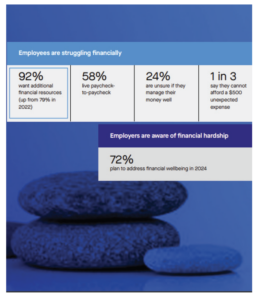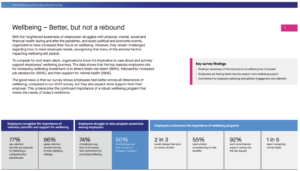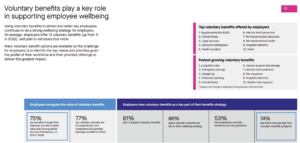Interviewed by Dan Vander Hey
This is an excerpt from an interview conducted on March 22, 2024, with Tom Kelly (Principal, Health and Benefits Practice, Gallagher) and Ruth Hunt (Principal, Engagement and Communications Practice, Gallagher), the lead authors of Buck, a Gallagher company’s biennial 2024 Wellbeing and Voluntary Benefits Survey. WSR Managing Editor Dan Vander Hey conducted the interview.
Dan: Let’s get started by giving our readers a better perspective on Buck’s biennial 2024 Wellbeing and Voluntary Benefits Survey. This comprehensive exploration of employee well-being provides a crucial snapshot of how U.S. employers rate their workforce’s mental, emotional, financial, social, and physical health. Its findings are informative and highly relevant for HR leaders and professionals interested in employee well-being and benefits. I love the lead you took with this survey, which said that things are better but is not a rebound. I had a similar reaction, as I initially thought, “Wow, better?” I know we’ve been struggling with COVID and all sorts of concerns about health and health care. I still sense this feeling amongst employees that they are apprehensive about “What’s next? What is the next thing we’re going to have to deal with?”
Ruth: We said, “Better, but not a rebound,” because our last survey in 2022, our fourth survey, showed clearly that perceptions and well-being were still in trouble. We were not “out of the pandemic.” The scores on the critical measures of well-being were more negative in 2022 than they are overall right now. You can tell we’ve emerged to a new reality, a different “normal”. However, the challenge is still huge as you look at the data. One in five 1 employees report worsening mental, physical, and financial health. If you look at the aggregate score, we have seen some improvements; but we have a sizable group that’s getting worse. We have a large segment of 92% (Figure 1) that wants more financial support. For the employers who wish to declare any victory on wellbeing, which is very few, they want to say that wellbeing is improving from their vantage point. But employees say, “Not so fast.”
 Figure 1.
Figure 1.
Tom: One of the values of this survey is the ability to compare the viewpoints of employees and employers. We continue to see that employers need to be aware of gaps when building a benefits strategy. For example, one of our major insights from this research is the belief that improving employees’ financial well-being should be the employer’s top priority as it relates to wellbeing initiatives and saving money. Saving money was listed at the top among employee priorities. In contrast, employers rank that lower, tending to prioritize things like attraction, retention, productivity, absenteeism, etc.
The message when we talk to organizations is that there were many years when financial well-being was defined purely as retirement readiness. Fast forward to today, we see that 58% of employees say they live paycheck to paycheck. About 55% say they’re doing the same or worse financially since a year ago, and only one in three employees can afford a $500 unexpected expense. So, these data points show that employees are under financial stress. Inflation only makes things more difficult. Employers are stepping in, saying we need to provide more resources. Employees want real money-saving solutions.
Ruth: It’s intriguing to see that over the time we’ve conducted the survey, employee demand and expectations of their employer and the employer/employee relationship have only risen. We did the correlative analysis to look at data on top retention drivers aside from pay. The first three were about job satisfaction and trust in management. Drivers four and five were, “Prove you care about my well-being” and “Deliver a good benefits package.” If I want to trust my management and have a comfortable view of my job, my employer needs to prove that they care about me besides issuing my paycheck and providing benefits.
Dan: I want to discuss a couple of significant variances with you. One that jumped out was that 75% of employers said they increased their commitment to promoting well-being. And yet, only 50% of employees say they have seen an increase in support. That nearly 25% variance is like a huge opportunity. Employers say, “We’re doing things to improve well-being,” yet a quarter of the population says, “Oh, no, you aren’t.” Tell me more about the disconnect between employers thinking they’ve got it and doing something good versus employees failing to realize it.
Tom: Employers need to ensure they’re offering the right programs. Now more than ever, it’s key for organizations to be more targeted, selective, and focused on what they’re offering. The other priority is communication and engagement. 55% of employees say they don’t understand their benefits, and ratings worsen the younger they go. Younger employees were also less likely to stay with the organization. And younger employees want more resources, overall.
As we looked at data around the types of programs, it’s clear younger employees want more flexibility and choice. Among employers, it’s why 67% of organizations want to infuse more personalization into their benefits package, and 77% of employees say voluntary benefits are essential to a benefits strategy. It’s all about offering flexible choices and aligning those programs with the right workforce segments based on specific needs in voluntary benefits. (Figure 2)

Figure 2.
Dan: I was fascinated by your well-being quadrant, which was differentiated by Gen Z, Millennials, Gen X, and Boomers. How do employers deal with the variance in these groups?
Ruth: Ask people! Do an assessment. Where is your workforce? For instance, parents need help with childcare and education, and they’re worried about their child’s future. And they probably know, to your point on retirement, that they should be maximizing their 401(k) plan. Ask people where they’re at, and then you can look at an inventory of your current offerings, identify which ones are underutilized, and make enhancements that will have the most significant ROI.
Tom: Millennials generally represent the largest segment of the US workforce today, and our survey showed that within that segment, there’s greater interest in topics like child education, caregiving, pregnancy, fertility, and new baby support. Understanding your population and the makeup of the other data points from the survey provides additional insights. We can craft a more targeted benefit strategy based on your workforce. That’s key for HR leaders.
Dan: One area was at least potentially contentious. This was the question where you assessed whether employees are better off this year than in the past, including whether employees feel better off financially this year. So what’s your assessment: are people better off, or are they worse off? Please help me understand your assessment and why you believe there’s empirical data to say one way or another.
Ruth: That’s the difference between this assessment’s aggregate data and a closer look at subgroups. If you look at the aggregate, the intense pain that we were feeling during the pandemic timeframe included a lot of socio-political division and the isolation that happened with the quarantine and people struggling. The challenge now depends on your vantage point. Some subgroups we’ve been discussing, like younger employees, have poorer self-ratings that make perfect sense. They’re coming out of school at low pay levels, and some of them feel underemployed. When it comes to their physical and financial well-being, they might have been on their parents’ benefits until they were 26, so they didn’t fully understand what employer benefits are like. They’re still learning how to address some basics, like making it on a budget and stretching their paycheck. Boomers have different types of struggles, such as “How will I be able to afford retiree medical care?” That’s why the “Better, but no rebound,” assessment. Overall, you’ve got to look at the macro, not just the micro.
Tom: I agree with Ruth that you must dig into the segments to see if there are notable differences. We see that 58% of employees live paycheck to paycheck. That’s up from 54% the last time we did the survey. One in three employees wants additional support for unexpected medical expenses, up from 23% in 2020. 56% of employees say inflation or rising costs will impact their ability to obtain health care in the coming years. So, it’s clear there is significant financial stress, which is why it’s no surprise that employees want more resources. I think if there’s an area for employers to focus on, that’s undoubtedly an excellent place to start.
Ruth: And to be fair, there are interdependencies here. The challenge is that the minute you’re hurting financially, you’re also hurting emotionally. It’s incredibly distracting to productivity and your commitment to your job. The feeling that “This is an excellent place to work” ends up being so intertwined with other factors that it’s hard even to pull some of those pieces apart relative to how we support holistic well-being. But you have to start somewhere and return to that prioritization, asking, “What can we do that will make a difference?” And that’s things like “Help me with my credit score, help me know what to do about emergency savings, help me figure out how to afford childcare, those kinds of real-world tactical things you can do to help my life better be better day to day”
Dan: So, tell me, with rising medical costs and the impact on an employee’s financial well-being, how are people dealing with that? How do you think employees and employers should deal with that issue? The inevitable is that it just keeps getting worse.
Tom: We’ve discussed creativity. Employers must look beyond traditional health and benefit plans. Traditional retirement plans and health care may not be enough. We also discussed infusing greater personalization, choice, and flexibility. I think employers know it’s a challenge for HR leaders because of the pressures and the headwinds with respect to budgets, dollars, and investment of time. That’s why we see the tie between voluntary benefits and our survey. 86% of employers said voluntary benefits are an essential part of a well-being strategy, while 77% of employees believe voluntary benefits are an integral part of a well-being strategy. Going back to the description of voluntary, it’s a way for organizations to strategically round out their benefits package and fill gaps in their benefits package. This involves helping them be better prepared when they face unexpected medical expenses or the 56% that say they will forgo medical costs because of the influence of inflation risk. So putting in supplemental medical options for employees to help them de-risk unexpected expenses is one strategy an organization can use. (Figure 3)

Figure 3.
Ruth: By way of illustration, supplemental medical is a perfect example. If I know I’m going to have a baby or major surgery and I’m going to be hospitalized, I should be signing up for hospital indemnity insurance on top of my medical. It’s going to help me with cash. There are many other medical payments and financing programs resources where you can help people with their great fears of medical debt and how they will deal with that cost.
Tom: Another good example is student loan debt. The federal pause on student loans expired last year, and many people need to start making those student loan payments again. This is an example of how employer organizations can step in, and it doesn’t necessarily have to cost them a lot of money. This can help employees access programs that may even be federal programs that will help them save money on their student debt, cap their monthly payments, or offer loan forgiveness over time based on their income level. So organizations can act strategically to broaden the resources available to help put real money back into their employees’ paychecks.
Dan: I understand that voluntary benefits are the way of the world today and the direction everyone should be going. Out of curiosity, please tell me what voluntary innovations and variances you see in that area.
Tom: There was a time when voluntary benefits included maybe five or ten kinds of unique offerings. The menu we support today has at least 75 to 100 unique benefit options. In many ways, when we look across all dimensions of well-being, it may be defined by our voluntary benefits product list, which includes medical financing programs, loan programs, emergency savings, banking products, or mortgage and refinance programs. Long-term care has made a huge resurgence in terms of supporting employees. I’d say for employers, when we define voluntary, it could either be offering a subsidized benefit or looking at the marketplace for competitive options. You also look at emerging needs within the population, such as mental health or caregiving resources for your employee population. So, the voluntary menu has evolved based on the workforce’s needs. And that’s what we’re always trying to stay in front of here, even working on product innovation and proactively bringing products to our clients based on employee needs.
Employees want more flexibility, more choices, and more options. Again, there’s a balancing act there, though, since you don’t necessarily want to offer everything under the sun. You have to be very strategic when introducing new programs. I would say that the communication strategy is even more important than the products themselves, ensuring you’re packaging it correctly.
Ruth: Let’s also talk about the communication gap and how we get employees to use their benefits. Part of our research asked about preferred communication channels, and not surprisingly, email tops the list. It always does based on usage and is the most popular with employers because it’s free, right? I can blast out many emails and hope that people read them. But it could be less preferred by employees because they’re getting overloaded. One of the interesting disconnects is web platforms, internet, intranets, etc. Use does keep rising on those, but they’re also disconnected when employees say how effective they are.
Employees want more personalization and relevance, but technology should be able to make things more relevant. The challenge often is that we did one-size-fits-all benefits packages in the past, and we’re still sometimes using one-size-fits-all technology. And users must be able to more easily search and find trusted, easy-to-understand information. When I conduct employee focus groups, I see people who say I can’t find anything. And that’s part of the challenge. Employers love technology because the information can be all there (or maybe in multiple locations). But too often, we hear employees say they can’t navigate and find what is needed, relevant information. So we can do better with better technology tools.
The other employee request is for more decision support. So on an annual basis, can you help me choose my medical plan or decide whether to contribute to a flexible spending or Health Savings Account? Should I select long-term care, insurance, or whatever those decisions may be? Decision support tools can help employees figure out what to do with their limited resources and how to prioritize.
We see some big gaps that employers can fill. Regarding people, processes, and technology, we can improve processes and programs, and continue enhancing our technology, support, and navigation for an improved employee experience that meets employee goals for improved well-being while meeting employer goals for attraction, retention, and productivity.
Dan: Tom and Ruth, you both have been eloquent in your answers.
____________________________________________________________________________________________



